AUDI A7 2012 Repair Manual
Manufacturer: AUDI, Model Year: 2012, Model line: A7, Model: AUDI A7 2012Pages: 294, PDF Size: 73.33 MB
Page 61 of 294
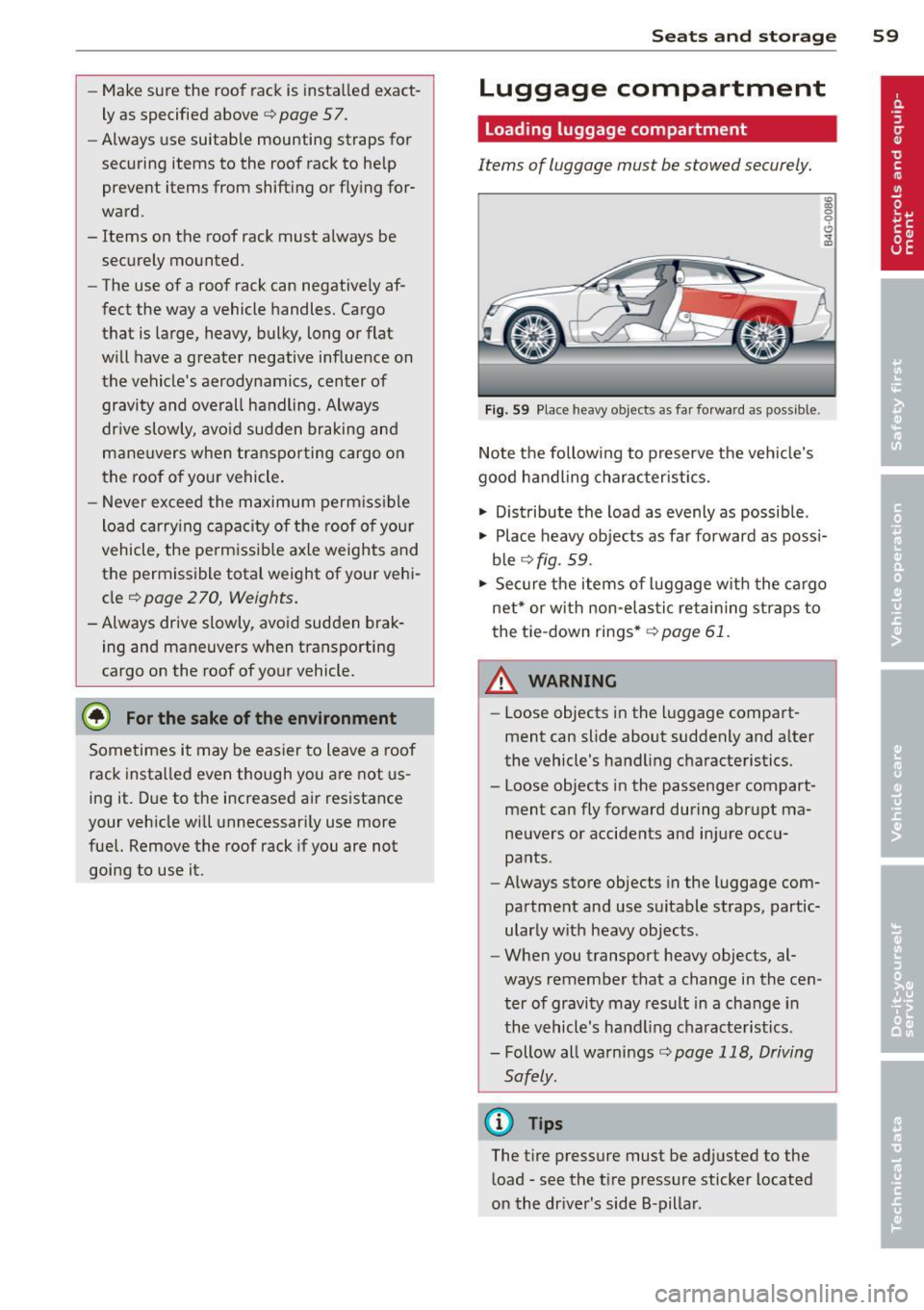
-Make sure the roof rack is instal led exact
ly as specified above
c::> page 57.
- Always use suitable mounting straps for
securing items to the roof rack to help
prevent items from shifting or flying for
ward.
- Items on the roof rack must always be securely mounted.
- The use of a roof rack can negative ly af
fect the way a vehicle handles. Cargo
that is large, heavy, bulky, long or flat
will have a greater negative influence on
the vehicle's aerodynamics, center of
gravity and overall handling. Always dr ive slowly, avo id sudden braking and
maneuvers when transpo rting cargo on
the roof o f your vehicle .
- Never exceed the maximum perm iss ible
load carry ing capacity of t he roof of your
vehicle, the perm issib le axle weights and
the permissible total weight of your vehi cle
c::> page 270 , Weights.
- Always drive slowly, avoid sudden brak
ing and maneuvers when transporting
cargo on the roof of your vehicle.
@ For the sake of the environment
Sometimes it may be easier to leave a roof
rack insta lled even though you are not us
ing it. Due to the increased air resistance
your vehicle will unnecessari ly use more
fuel. Remove the roof rack if you are not going to use it.
Sea ts a nd s to rage 59
Luggage compartment
Loading luggage compartment
Items of luggage must be stowed securely.
Fig. 59 Place heavy objects as far forward as possible.
Note the following to preserve the vehicle's
good handling charac teristics.
.., Distribute the load as evenly as possible .
.., Place heavy objects as far forward as poss i
ble
c::> fig. 59.
.., Secure the items of luggage w ith the cargo
net* or w ith non -elastic retaining straps to
the tie-down rings *
c::> page 61.
A WARNING
-Loose objects in the l uggage compart
ment can slide about suddenly and a lter
the vehicle's handling characteristics.
- Loose objects in the passenger compart
ment can fly forward during abr upt ma
neuvers or accidents and injure occu
pants .
- Always store objects in the luggage com
partment and use suitable straps, partic
ularly with heavy objects.
-
- When you transport heavy objects, al
ways remember that a change in the cen
ter of gravity may result in a change in
the vehicle's handling characteristics.
- Follow all warnings
c::> page 118, Driving
Safely.
(D Tips
The t ire pressure must be ad justed to the
load -see the t ire pressure sticker located
on the dr iver's side B-pillar .
Page 62 of 294
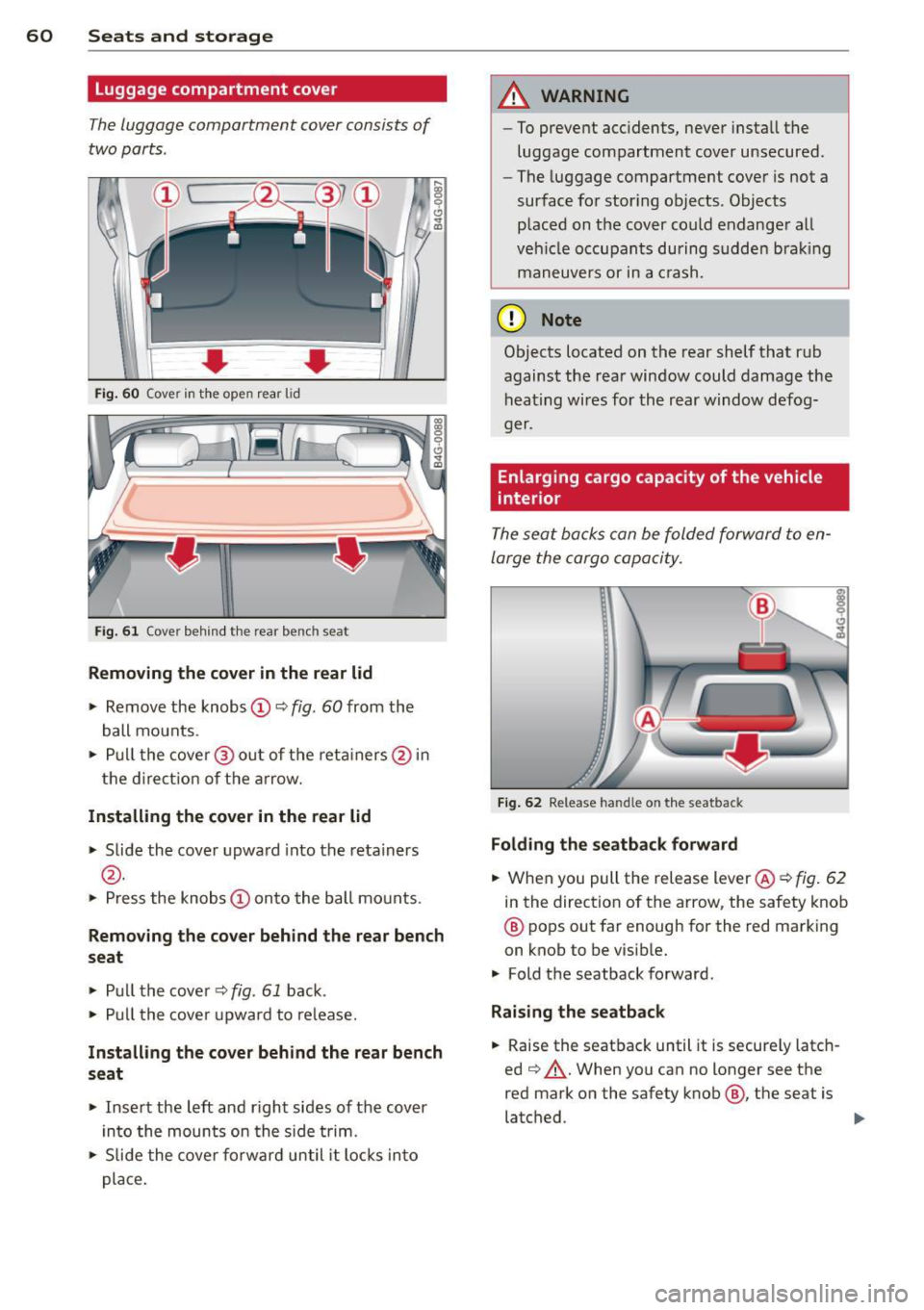
60 Seats and st o rage
Luggage compartment cover
The luggage compartment cover consists of
two parts .
• • Fig. 60 Cover in t he open rear lid
Fig. 61 Cover behind t he rear bench seat
Removing the cov er in the r ear lid
.. Remove the knobs CD¢ fig. 60 from the
ball mounts .
.. Pu ll the cove r@ out of the reta iners @in
the d irect ion of the a rrow.
Install ing th e cover in the rear lid
.. Slide the cover upward into the retainers
@ .
.. Press the knobs CD onto the ball mounts.
9 C) .. (D
Rem oving the cov er behind the rear bench
seat
.. Pull the cove r¢ fig. 61 back .
.. Pull the cove r upward to re lease.
In sta ll ing th e co ver behind the rear bench
seat
.. Inse rt the left and r ight sides of the cover
in to the mounts on the s ide trim .
.. Slide the cover forward until it locks into
place .
A WARNING
--To prevent acc idents, never insta ll the
luggage compartment cover unsecured .
- The luggage compartment cover is not a
surface for storing objects. Objects
p laced on the cover co uld endanger all
veh icle occupan ts during sudden bra king
maneuvers or in a c rash.
(D Note
Objects located on the rear shelf that rub
against the rear window could damage the heating wires for the rear window defog-
ger.
Enlarging cargo capacity of the vehicle
interior
The seat backs can be folded forward to en
large the cargo capacity.
F ig . 62 Release handle on the seatback
Folding th e seatba ck forward
.. When you pull the release lever @¢ fig. 62
in the direction of the arrow, the safety knob
@ pops out far enough for the red marking
on knob to be visible.
.. Fold the seatback forward .
Raising th e se atb ack
.. Raise the seatback until it is secure ly latch
ed ~,&. .When you can no longer see the
red mark on the safety knob @, the seat is
latched . ..,
Page 63 of 294
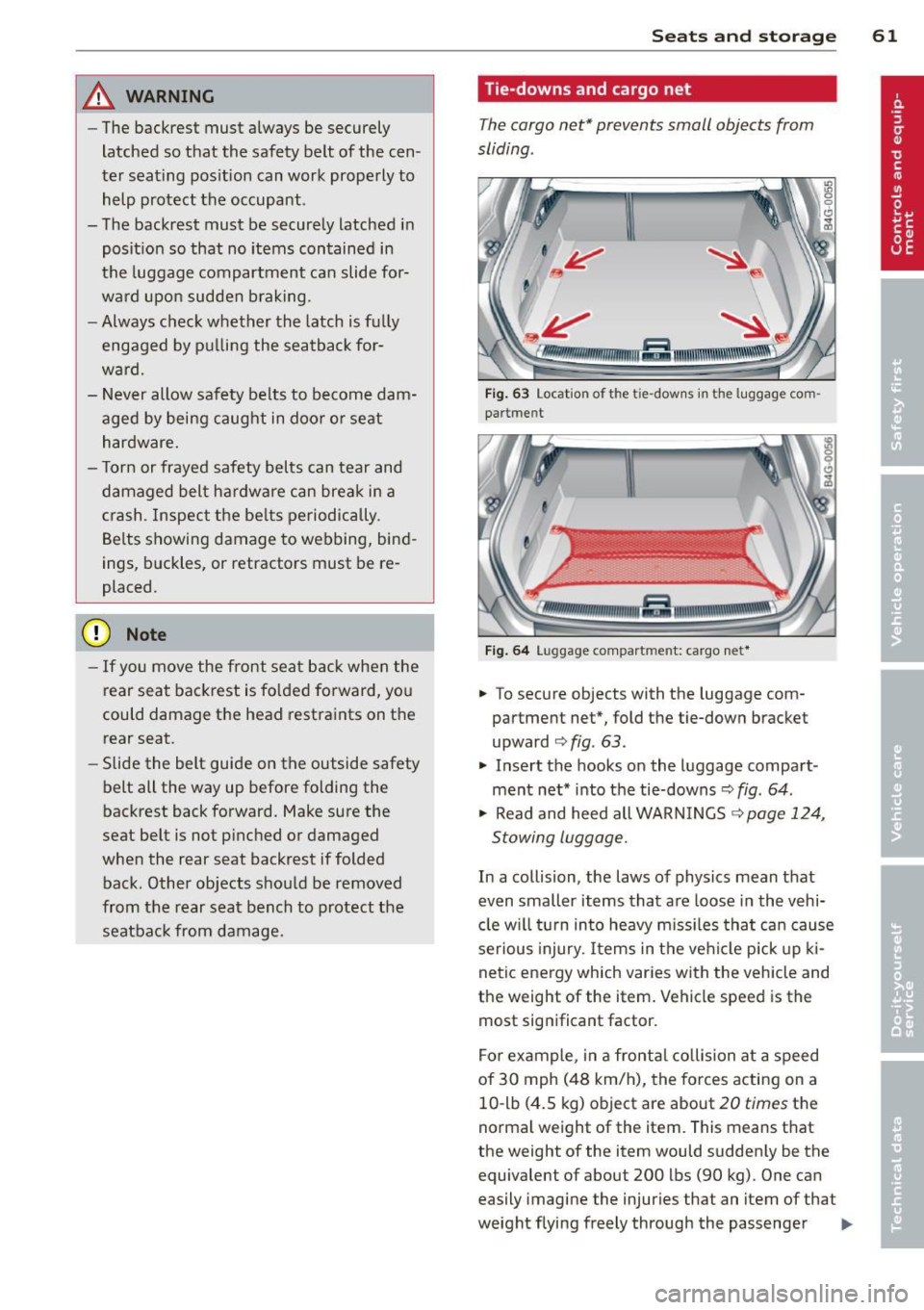
_& WARNING
-The backrest must always be securely
latched so that the safety belt of the cen
ter seating pos ition can work properly to
help protect the occupant.
- The backrest must be securely latched in position so that no items contained in
the luggage compartment can slide for
wa rd upon sudden braking .
-Always check whether the latch is ful ly
engaged by pu lling the seatback for
ward.
- Never allow safety belts to become dam
aged by being caught in doo r o r seat
hardware.
- T orn or frayed safety belts can tear and
damaged belt ha rdware can break in a
crash . Inspect the be lts period ically .
Belts showing damage to webbing, bind
ings, buckles, or retractors must be re
placed.
(D Note
- If yo u move the front seat back when the
rear seat backrest is fo lded forward, you
could damage the head restraints on the rear seat.
- Slide the belt guide on the outside safety
belt all the way up before folding the
backrest back forward. Make sure the
seat belt is not pinched or damaged
whe n the rear seat backrest if folded
back. Other objects should be removed
from the rear seat bench to protect the
seatbac k from damage.
S ea ts a nd s to rage 61
Tie-downs and cargo net
The cargo net* prevents small objects from
sliding .
Fig . 63 Locat ion of t he t ie -dow ns in the lu ggage co m
partme nt
r.lllf2z:::11:,;;;,1m,mn,um- .f31111mffi11\\\\\iUt1tlil!IIII.
Fig . 6 4 Luggage compart men t: cargo net *
.. To secure objects with the luggage com
partment net*, fold the tie-down bracket
upward
r:> fig . 63 .
.. Insert the hooks on the luggage compa rt
ment net* into the tie-downs
r:> fig. 64 .
.,. Read and heed all WARN INGS r:> page 124,
Stowing luggage.
In a collision, the laws of physics mean that
even smaller items that are loose in the vehi·
cle w il l turn in to heavy m iss iles that ca n cause
serious injury. Items in the vehicle pick up ki
netic ene rgy which varies with the vehicle and
the weight of the item. Vehicle speed is the
most significant factor.
For example, in a fronta l collision at a speed
of 30 mph (48 km/h), the forces acting on a
10 -lb (4.5 kg) object are about
20 times the
norma l weight of the item. This means t hat
the weight of the item would sudden ly be the
equivalent of about 200 lbs (90 kg). One can
easily imagine the injuries that an item of that
weight flying freely through the passenger .,,.
Page 64 of 294
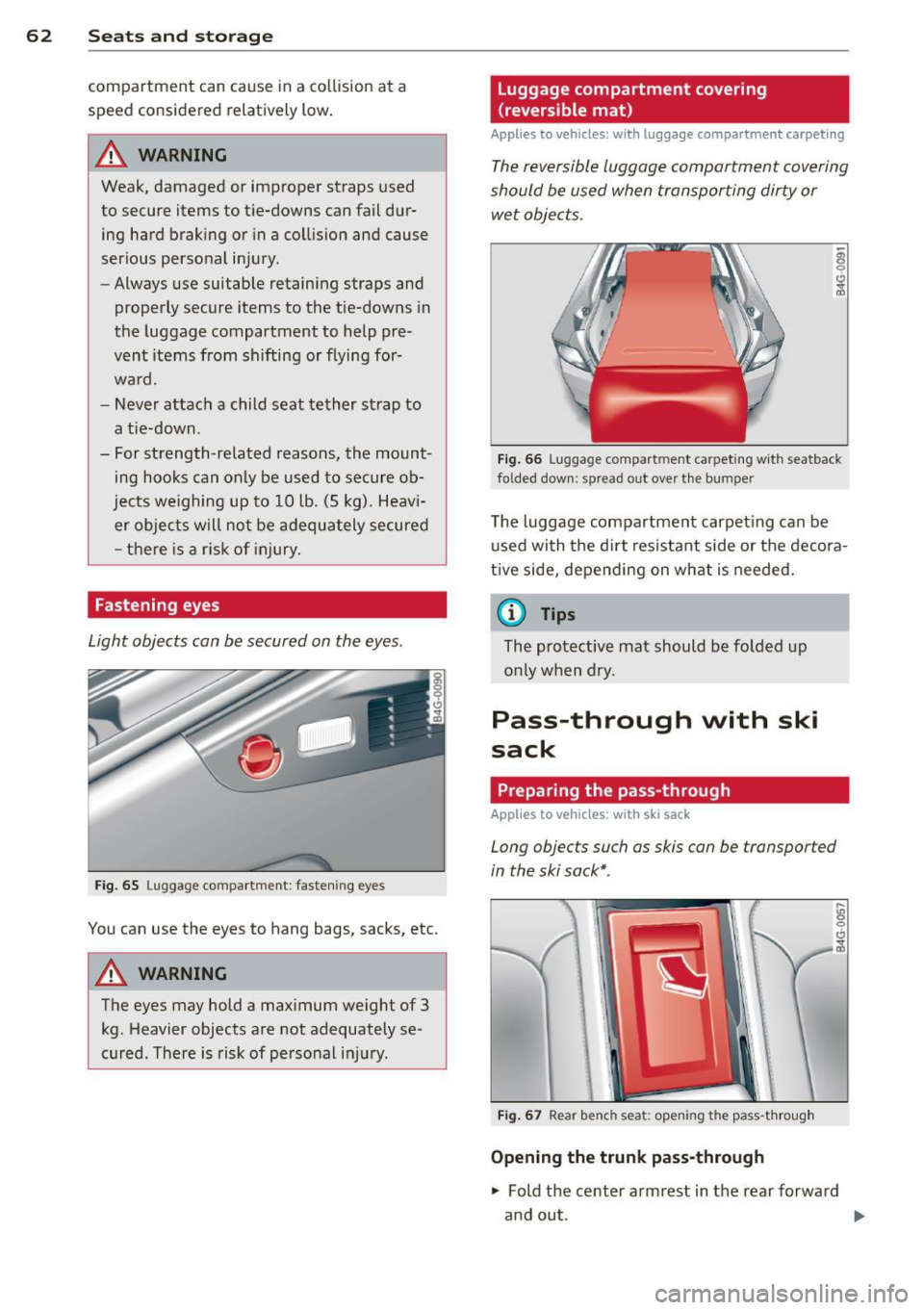
62 Seats and storage
compa rtment can cause in a co llision at a
speed considered relatively low .
.&_ WARNING
Weak, damaged or improper straps used
to secure items to tie-downs can fail dur
ing hard brak ing or in a coll ision and cause
ser ious personal injury.
- Always use suitable retaining straps and
properly secure items to the tie-downs in
the luggage compartment to help pre
vent items from shifting or flying for
wa rd.
- Never attach a child seat tether strap to
a tie-down.
- For strength-related reasons, the mount ing hoo ks can only be used to s ecure ob
jects weighing up to 10 lb. (5 kg). Heav i
er objects will not be adequately secured
- there is a r isk of injury.
Fastening eyes
Light objects can be secured on the eyes .
Fig. 65 Luggage compartment: fastening eyes
You can use the eyes to hang bags, sacks, etc .
.&_ WARNING
The eyes may hold a max imum weight of 3
kg. Heavier objects are not adequately se
cured. There is risk of personal injury.
Luggage compartment covering
(reversible mat)
Applies to veh icles : w ith lug gage compartme nt car petin g
The reversible luggage compartment covering
should be used when transporting dirty or wet objects.
F ig . 66 Luggage compartment carpeting with seatback
fo lded down: spread o ut over t he bumper
The luggage compartment carpeting can be
used with the d irt resistant side or the decora
t ive side, depending on wh at is needed.
u) Tips
The protective mat should be folded up
on ly when dry.
Pass-through with ski
sack
Preparing the pass-through
Applies to veh icles: w it h sk i sack
Long objects such as skis can be transported
in the ski sack* .
Fig . 67 Rear bench seat : opening the pass-t hr oug h
Opening the trunk pass -through
... Fold the center a rmrest in the rear forward
and out. .,.
Page 65 of 294
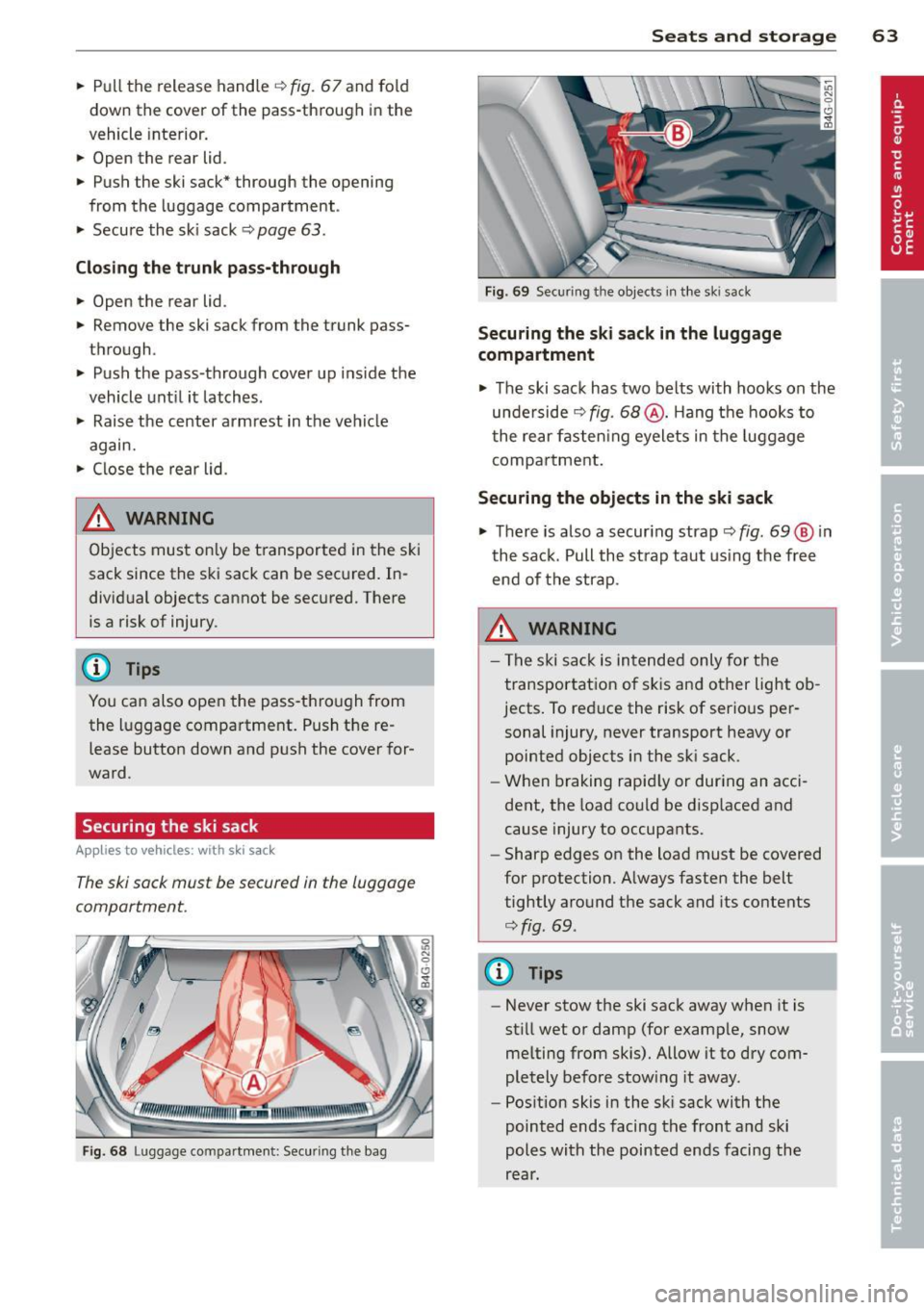
.. Pull the release handle c;,fig . 67 and fold
down the cover of the pass-through in the
vehicle interior .
.. Open the rear lid .
.. Push the ski sack* through the opening
from the luggage compartment .
.. Secu re the ski sack
c::> page 63 .
Closing the trunk pass-through
.. Open the rear lid .
.,. Remove the ski sack from the trunk pass
through .
.. Push the pass-through cover up inside the
vehicle until it latches .
.. Raise the center armrest in the vehicle
again.
.. Close the rear lid .
& WARNING
Objects must only be transported in the ski
sack since the ski sack can be sec ured. In
divid ual objects cannot be secured. There
is a risk of injury .
@ Tips
You can also open the pass-through from
the luggage compartment. Push the re
lease button down and push the cover for
ward .
Securing the ski sack
Applies to vehicles: wit h ski sack
The ski sack must be secured in the luggage
compartment .
Fig. 68 Luggage compartment: Securing the bag
Seats and storage 63
Fig. 69 Secur ing t he objects in the ski sack
Securing the ski sack in the luggage
compartment
.. The ski sack has two belts with hooks on the
unde rside
c;, fig . 68 @. Hang the hooks to
t he rear fasten ing eyelets in the luggage
compartment .
Securing the objects in the ski sack
.,. There is also a secur ing strap c::> fig. 69 @ in
the sack. Pull the strap taut using the free
end of the strap.
& WARNING ~ -
-The ski sack is intended only for the
transportation of skis and other light ob
jects . To reduce the risk of serious per
sonal injury , never transport heavy or
pointed objects in the sk i sack.
- When braking rapidly or dur ing an acci
dent, the load could be disp laced and
cause injury to occupants.
- Sharp edges on the load must be covered
for protection. Always fasten the belt
tightly around the sack and its contents
c::> fig . 69 .
(D Tips
-Never stow the ski sack away when it is
st ill wet or damp (for examp le, snow
me lting from skis). Allow it to dry com
pletely before stow ing it away.
- Position skis in the ski sack with the
pointed ends facing the front and ski
poles with the pointed ends facing the
rear .
Page 66 of 294
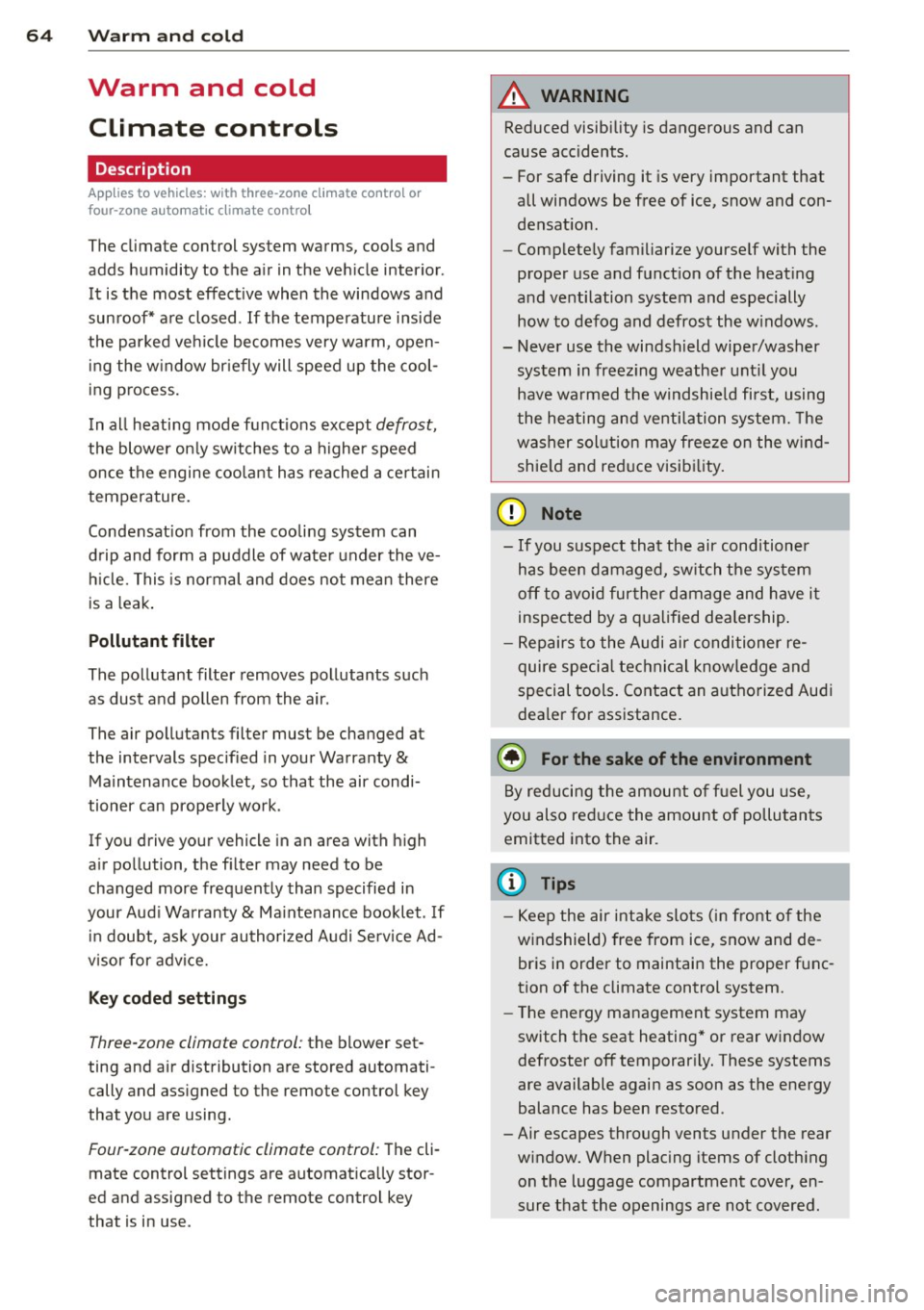
64 Warm and cold
Warm and cold
Climate controls
Description
App lies to vehicles: with three-zone climate control or
four-zone automat ic climate contro l
The climate control system warms, cools and
adds humidity to the air in the vehicle interior .
It is the most effective when the windows and
sunroof* are closed .
If the temperature inside
the parked veh icle becomes very warm, open
ing the w indow br iefly will speed up the cool
ing process.
In all heating mode functions except
defrost,
the blower on ly switches to a highe r speed
once the engine coolant has reached a certain
temperature.
Condensat ion from the cooling system can
d rip and form a puddle of wate r under the ve
h icle. This is normal and does not mean there
is a leak .
Pollutant filt er
The pollutant filter removes pollutants such
as dust and po llen from the air.
The air pollutants filter must be changed at
the intervals spec ified in your Warranty
&
Maintenance booklet, so that the air condi
tioner can properly work .
If you drive your vehicle in an area with h igh
a ir pollution, the filter may need to be
changed more freq uently than specified in
your Aud i Warranty & Ma intenance booklet . If
i n doubt, as k your author ized Audi Se rvice Ad
visor for adv ice.
K ey coded setting s
Three-zone climate control: the blower set
ting and air distribution are stored automati
cally and ass igned to the remote control key
that you are using.
Four-zone automatic climate control: The cli
mate control settings are automatica lly stor
ed and assigned to the remote control key
that is in use .
A WARNING
Reduced visibility is dangerous and can
cause accidents.
-
- For safe driving it is very important that
all windows be free of ice, snow and con
densat ion .
- Comp lete ly fami liarize yourse lf with the
proper use and funct ion of the heat ing
and venti lation system and especially
how to defog and defrost the w indows.
- Never use the windshield wiper/washer system in freez ing weather unt il you
have wa rmed the windshie ld first, using
the heating and ventilation system. The
washer sol ution may freeze on the w ind
shie ld and red uce visib ility.
(D Note
- If you suspect that the air conditioner
has been damaged, switch the system
off to avoid further d amage and have i t
inspected by a q uali fied dealership .
- Repairs to the Audi air conditioner re
quire speci al technical know ledge and
special tools. Contact an authorized Audi
dea ler fo r ass istance.
@ For the sake of the environment
By reducing the amount of f uel you use,
you also red uce the amount of pollutants
emitted into the air.
(D Tips
- Keep the air intake s lo ts (in front o f the
windshield) free from ice, snow and de
bris in order to maintain the proper func
tion of the climate control system.
- The energy management system may
switch the seat heating* or rear window
defroster off temporar ily. These systems
are available again as soon as the energy
balance has been restored .
-Air escapes through vents under the rear window. When plac ing items of cloth ing
on the luggage compartment cover, en
sure that the openings are not covered.
Page 67 of 294

Warm and cold 65
Three-zone climate control
Operation
Applies to vehicles: with three-zone climate control
We recommend pressing the !AUTOI button and setting the temperature to 72 °F (22 °C).
F ig. 70 Three -zone cl imate control : controls
Press the buttons to turn the funct ions on or
off. The dial adjusts the temperature and the
blower . The LED in the buttons illuminates
when the funct ion is active.
IAUTO I Switching automatic mode on
Automatic mode maintains a constant tem
perature inside the vehicle. Air temperature,
airflow and air d istribution are controlled au
tomatically.
e °F e Adjusting the temperature
The temperature can be adjusted individually
for the driver and front passenger using the
d ials (!) and @.
8fr Adjusting the airflow
Using the dial@, you can manually adjust the
amount of air generated by the blower to suit
your preferences . To have the airflow regulat
ed automatically, press the
! AUTO ! button.
~. rill, [2] Adjusting the air distribution
You can manually se lect the vents where the
air will flow. To have the air distribution regu lated automatically, press the
!AUTOI button .
l""" I Switching recirculation mode on/off
In recirculation mode, the air inside the vehi
cle is circulated and filtered. This prevents the
unfiltered air outside the veh icle from enter
ing the vehicle interior . We recommend
switching recirculation mode on when dr iving
through a tunnel or when sitting in traffic
~.& -
The !AUTO ! button or~ button switches recir
cu lation mode off.
I OFFI Switching the climate control
system on/off
The ! O FF! button switches the climate con trol
system on or off.
It also switches on when yo u
turn the dial or press any button. Airflow from
outside is blocked when the climate control
system is switched off.
IACI Switching cooling mode on/off
The air is not coo led and humidity is not re
moved when cooling mode is switched off .
This can cause fog on the w indows. Cooling
mode switches off automatically when the
outside temperature is be low zero.
Page 68 of 294

66 Warm and cold
l
ed or cleared o f condensation as quickly as
possib le. The maximum amo unt of air flows
mainly from the vents below the windshield.
Recirculation mode switches off .
The
IAU TOI b utton switches the defroster off.
ICmJ REAR I Switching rear window heater
on /off
The rear w indow heater only operates when
the engine is running . It switches off auto
matica lly after a few minutes, depending on
the outside temperature.
To prevent the rear w indow heater from
switch ing off automatically, press and hold
the ~ button for more than 2 seconds. This
remains stored unti l the ignition is switched
off.
~ Ad justing s eat h eat ing
Press ing the button switches the seat heat ing
on at the highest setting ( leve l 3) . T he LEDs
indicate the temperature leve l. To reduce the
temperature, press the button again. To
switch the seat heating off, press the button
repeatedly unt il the LED turns off.
After 10 minutes, the seat heating automati
cally switches from leve l 3 to level 2.
The seat heating for both outer rear seats* is
ad justed using the buttons in the center con
sole.
Air vents
You can open or close the center and outer
vents in the cockpit and the vents in the rear center console using the ridged thumbwhee ls.
The levers adj ust the direction of the airflow
from the vents.
T he air temperature in the rear can be ad just
ed so that it is warmer or co lder by turning
the knob to the red or blue area.
A WARNING
- Do not use th is sett ing for extended peri
ods of time. The w indows could fog up
since no fresh air can enter the vehicle. If
the wi ndows fog up, press the air rec ircu
lation button again immed iate ly to
sw itch off the air recircu lation function
or select defrost.
- I ndividuals w ith reduced sensitivity to
pa in or temperature cou ld deve lop burns
when using the seat heating fu nction. To
red uce the risk of injury, these indiv idu
a ls shou ld not use seat heating.
0 Note
To avoid damage to the heat ing elements
i n the seats, do not kneel o n the sea ts or
place heavy loads on a sma ll area of the
seat.
Page 69 of 294

Warm and cold 67
Four-zone automatic climate control
Operation
Applies to vehicles: with four -zone a utomat ic climate control
We recommend pressing the IAUTOI button and setting the temperature to 72 °F (22 °C).
F ig. 71 Four -zone automat ic climate control: controls
Fig. 72 Four -zone automat ic climate control: rear con·
trols
Press the buttons to turn the functions on or
off. Use the dials to adjust the temperature,
the blower speed and the air distribution. The
LED in a button will light up when the func
tion is switched on. The settings are shown in
the climate control display and are also shown in the MMI display for a few seconds . The driv
er and front passenger settings can be adjust·
ing separately.
The settings can also be adjusted in the rea r
<::>fig. 72.
IOFFl Switching the climate control
system on/off
The IOFFI button switches the climate control
system on or off .
It also switches on when you
turn the dial or press any button. Airf low from outside is blocked when the
climate control
system is switched off.
You can activate the residual heat funct ion
when the ignition is off by pressing and hold
ing the ~ button. The residual heat from the
coolant is used to heat the vehicle interior.
The residua l heat function switches off auto
matically after about 30 minutes.
IACI Switching cooling mode on /off
T he air is not coo led and humidity is not re
moved when cooling mode is switched off.
This can cause fog on the windows. Cooling
mode switches off automatically when the
outside temperature is below zero.
1-1 Switching recirculation mode on/off
In recircu lation mode, the air inside the vehi
cle is circ ulated and filtered. This prevents the
unfiltered air outside the vehicle from enter
ing the vehicle interior. We recommend
switching recirculation mode on when driving
through a tunnel or when sitting in traffic
¢ Li). .
The !AUTO ! button or~ button switches recir-
culation mode off. .,..
Page 70 of 294

68 Warm and cold
IAUTO I Switching automatic mode on
Automatic mode m ainta ins a constant tem
perat ure inside the vehi cle. Air tempera ture,
airflow and air d istribution a re controlled a u
tomatically.
Adjusting the temperature
T empe ratu res between 60 °F (+16 °C) and
84 °F ( +28 ° C) c an be se t. O uts ide of this
range,
lo or hi w ill appear in the climate con
trol system disp lay. At both of these settings,
the cl imate control system r uns continuously
at max imum cooling or heat ing power. There
is no temperature regu lation.
~ Adjusting the airflow
You can a djust the airf low manually to s uit
your needs . To have the airf low reg ulated a u
tomatically, press the
! AUTO ! button.
~ Adjusting the air distribution
You can manu ally se lect the ve nts w here the
a ir will flow. To have the air d istribu tion reg u
l ated automatically, press the
IAUTOI bu tton.
~ I~ * Adjusting seat heating/
ventilat ion*
Pr ess ing the button swi tches the sea t heat
ing/ventilation on at the highest sett ing ( leve l
3). The LEDs indicate the heating/venti lat ion
leve l. To reduce the heating/vent ilation, press
the butto n aga in. To switch the seat heat ing/
ve nti lation off, press the button repeatedly
u ntil the LED turns off.
After 10 minutes, the seat heating automati
cally switches from leve l 3 to level 2.
l
e d or cleared of con densation as quickly as
possib le. The max imum amo unt of air flows
mainly from the vents be low the windshield.
Recirculation mode switches off.
The
IAUTOI bu tton switches the defroster off.
lliiil REAR ! Switching rear window heater
on /off
T he rea r window heate r only operates w hen
the engine is running. It sw itches off auto
matically after 10 to 20 minutes, depending
o n the outside temperature.
T o p revent the rea r window heate r from
switching off automatically, p ress and ho ld
t h e ~ button for more than 2 seconds. Th is
rema ins stored until the ignition is switched
off .
ISYNC I Synchronization*
When synchronization is switched on, the
same settings are applied to bot h the dr iver
and fr ont passenger, except for the seat heat
i ng/venti lation *. The rear zo ne is also
synchronized. Synchronization switches off
whe n the se ttings for the front passenge r side
o r r ear are ad justed.
You can also switch synchronizati on o n by
pressing and holding a dial. For example, if
you press and hold t he di al on the front pas
senger si de, the setti ngs for that s ide a re
t ran sfer red to t he d rive r si de. The same ap
plies to the re ar.
Air vents
You can open o r close the center and ou ter
vents i n the cockpit and the vents in the rear
c ente r console and doo r pillars us ing t he
ridged t humbwheels. The levers adjust the d i
r ect ion o f the airfl ow from the vents.
A WARNING
-Do not use t his se tt ing fo r extended peri
ods of time . The w indows cou ld fog up
since n o fresh air can enter the vehicle. I f
the windows fog up, press the air rec ircu
lation butt on agai n immed iate ly to
sw itch off the air recirc ulation function
or sel ect defrost.
- Individ uals w ith reduced se nsitivity to
pa in or te mperature cou ld deve lop burns
when using the s eat heating fu nction . To
re duc e the risk of i njury, these i nd iv idu-
a ls should n ot us e sea t heating.
~